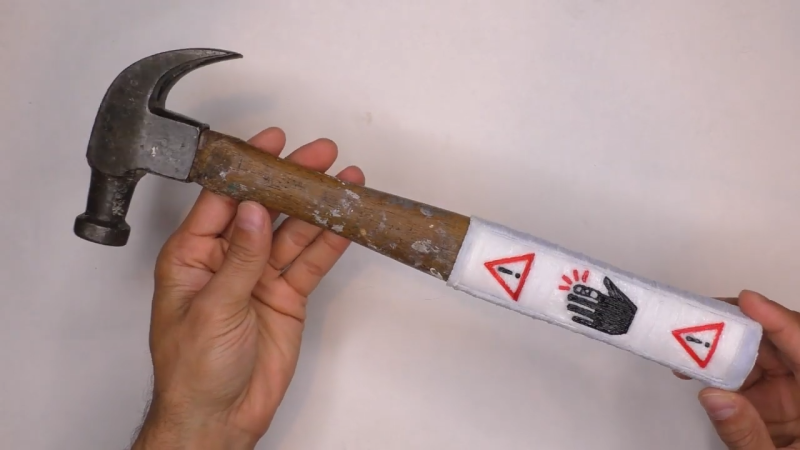When it comes to putting a flexible grip on a tool, you might reach for a self-fusing silicone tape or other similar product. However, [Potent Printables] has discovered you can easily create a flexible grip using a 3D-printing pen and some flex filament.
In this case, a hammer first gets a layer of blue painters tape wrapped around its wooden handle. This serves as a base layer to promote good adhesion. A simple paper template was then printed as a guide for creating the graphics on the flexible grip. Flexible filament was fed through the 3D pen, with the red and black details of the graphics printed first. Then, white flex filament was used to make the rest of the flexible grip. A wood burning tool was then used to smooth out the first layer of flex filament, before a second layer was added on top.
The result is a flexible white grip on the hammer which is stuck fast, likely due to shrinkage as the plastic cooled after printing. We’ve seen some other creative grips made with 3D printing before, too. Video after the break.
[Thanks to Keith Olson for the tip!]















shoot, some people are just trying to make the rest of us look bad.
I’m not saying it’s unimpressive, but a can of PlastiDip is like $7.
Gotta keep making content somehow. The quality is unimportant.
Come on, this is a good quality video. There are more ways of doing stuff and this certainly is a novel way of tackling this problem. If you prefer the plastidip, go with the plastidip and make a video to show us how you did the symbols on the handle.
We’re the chumps for coming back to ArtsandCraftsaDay.
You know the saying, when you have a hammer, everything look like a nail.
I agree plastidip has a nice finish and takes 2 min to apply. But you don’t get the views by using 3D printing goo.
The grip is not the hack, the hack is finding something marginally useful to do with a handheld filament extruder. aka “3D printer pen” or whatevs.
Somehow in the early 90s, I got hold of a crap load of foam rubber grip tube intended for bicycle handlebars, so I was cutting pieces off and making deeeeeelux grips on hand tools… unfortunately it only lasted about 5 years before it all stiffened up and cracked off. IDK if I got hold of it cheap/free (Not recalling which) because it was a batch they forgot to put the UV stabiliser in or something. Anyway, it came off pretty clean, a little minor powdery crumbing.
But why? What does a flexible grip on a hammer really add? I don’t see much point in this.
[ ] Built for speed
[x] Built for comfort
And if you have carpal tunnel, you can actually do something for a while before it hurts too bad.
A nephew-in-law has an $700 titanium hammer.
It was a good investment for his carpentry work.
There are those that look at things the way they are, and ask why?
I dream of things that never were, and ask why not?
Some attribute that saying to Robert F. Kennedy
Sme as a (flexible) foam grip on a hammer: dampens the rebound forces, avoids getting splinters, improves the grip.
This one also has some graphics, probably a good place for a logo, or personalizing your favorite hammer so it doesn’t get accidentally lost in someone else’s tool bag.
My takeaway from this is that something I’ve always thought of as a toy (because that’s how I’ve always seen it marketed) may have potential uses.
Besides art projects, I’m interested in this as a way to apply grip to individual components. A button or knob could be done in situ pretty quickly this way. Could be superior to plastidip.